Spatiotemporal Variability of Soil Nitrogen in Relation to Environmental Factors in a Low Hilly Region of Southeastern China
Abstract
:1. Introduction
- (1)
- No systematic methodology exists that can be used to analyze the spatiotemporal changes in soil TN in conjunction with agricultural protection policies. Timely monitoring of the spatial distribution of soil TN can provide information on both the location and the amount of N in the soil; thus, explicitly linking changes in soil TN to agricultural protection regulations could be useful for understanding the dynamic patterns of N in soil [10] and for assessing the degree to which the Chinese STFFT decrease or increase soil TN in agricultural land.
- (2)
- Most DSM studies have focused on integrating hyperspectral data with field surveys and environmental parameters to monitor changes in soil TN [17]. However, archives of satellite sensor imagery such as Landsat data also include useful information that has not been fully exploited.
- (3)
- While DSM has been hailed as a very useful technique for assessing and monitoring soil TN [11], its applications thus far have been restricted to flat lands, partly because of the easy accessibility of such regions and partly because of the less complex environment. In contrast, the challenging environments of mountainous regions, which exhibit nonlinear relationships between soil properties and environmental predictors, have prevented researchers from analyzing the spatiotemporal patterns of soil TN therein [17], especially in terms of the relationship between soil TN and agricultural protection policies.
2. Materials and Methods
2.1. Site Description
2.2. Datasets
2.2.1. Soil Sample Collection and Laboratory Analysis
2.2.2. Environmental Variables
2.2.3. Remote Sensing Variables
2.2.4. Other Datasets
2.3. Prediction Models
2.3.1. Random Forest
2.3.2. Model Validation and Uncertainty
2.4. Data Processing
3. Results
3.1. Descriptive Statistics
3.2. Model Performance
3.3. Relative Importance of Environmental Variables
3.4. Spatiotemporal Distribution of Soil TN
4. Discussion
4.1. Model Performance
4.2. Roles of Environmental Factors
4.3. Spatiotemporal Distributions of Soil TN
4.3.1. Spatial Patterns of Soil TN
4.3.2. Temporal Changes in Soil TN
5. Conclusions
Author Contributions
Funding
Acknowledgments
Conflicts of Interest
Appendix A
References
- Powlson, D.S.; Gregory, P.J.; Whalley, W.R.; Quinton, J.N.; Hopkins, D.W.; Whitmore, A.P.; Hirsch, P.R.; Goulding, K.W.T. Soil management in relation to sustainable agriculture and ecosystem services. Food Policy 2011, 36, S72–S87. [Google Scholar] [CrossRef]
- Smith, P.; Cotrufo, M.F.; Rumpel, C.; Paustian, K.; Kuikman, P.J.; Elliott, J.A.; Mcdowell, R.; Griffiths, R.I.; Asakawa, S.; Bustamante, M. Biogeochemical cycles and biodiversity as key drivers of ecosystem services provided by soils. Soil 2015, 1, 665–685. [Google Scholar] [CrossRef]
- Stevens, C.J.; Dise, N.B.; Mountford, J.O.; Gowing, D.J. Impact of nitrogen deposition on the species richness of grasslands. Science 2004, 303, 1876–1879. [Google Scholar] [CrossRef] [PubMed]
- Wardle, D.A. A comparative assessment of factors which influence microbial biomass carbon and nitrogen levels in soil. Biol. Rev. 1992, 67, 321–358. [Google Scholar] [CrossRef]
- Bronson, K.F.; Zobeck, T.M.; Chua, T.T.; Acostamartinez, V.; Van Pelt, R.S.; Booker, J.D. Carbon and nitrogen pools of southern high plains cropland and grassland soils. Soil Sci. Soc. Am. J. 2004, 68, 1695–1704. [Google Scholar] [CrossRef]
- Liu, X.M.; Zhang, W.W.; Zhang, M.H.; Ficklin, D.L.; Fan, W. Spatio-temporal variations of soil nutrients influenced by an altered land tenure system in China. Geoderma 2009, 152, 23–34. [Google Scholar] [CrossRef]
- Velthof, G.L.; Lesschen, J.P.; Webb, J.; Pietrzak, S.; Miatkowski, Z.; Pinto, M.; Kros, J.; Oenema, O. The impact of the Nitrates Directive on nitrogen emissions from agriculture in the EU-27 during 2000–2008. In Proceedings of the Conference on Computer Vision & Pattern Recognition Workshop, Columbus, OH, USA, 24–27 June 2014; p. 55. [Google Scholar]
- Chen, T.E.; Zhao, C.J.; Chen, L.P.; Chen, H. Research on component-oriented decision-making support platform of soil testing and formulated fertilization. Appl. Res. Comput. 2008, 25, 2748–2750. [Google Scholar]
- Kong, X. China must protect high-quality arable land. Nature 2014, 506, 7. [Google Scholar] [CrossRef] [PubMed]
- Zhao, Y.; Wang, M.; Hu, S.; Zhang, X.; Ouyang, Z.; Zhang, G.; Huang, B.; Zhao, S.; Wu, J.; Xie, D.; et al. Economics- and policy-driven organic carbon input enhancement dominates soil organic carbon accumulation in Chinese croplands. Proc. Natl. Acad. Sci. USA 2018, 115, 4045–4050. [Google Scholar] [CrossRef] [PubMed] [Green Version]
- Wang, S.; Adhikari, K.; Wang, Q.; Jin, X.; Li, H. Role of environmental variables in the spatial distribution of soil carbon (C), nitrogen (N), and C:N ratio from the northeastern coastal agroecosystems in China. Ecol. Indic. 2017, 84, 263–272. [Google Scholar] [CrossRef]
- Holmberg, M.; Forsius, M.; Starr, M.; Huttunen, M. An application of artificial neural networks to carbon, nitrogen and phosphorus concentrations in three boreal streams and impacts of climate change. Ecol. Model. 2006, 195, 51–60. [Google Scholar] [CrossRef]
- Jeong, G.; Choi, K.; Spohn, M.; Park, S.J.; Huwe, B.; Ließ, M. Environmental drivers of spatial patterns of topsoil nitrogen and phosphorus under monsoon conditions in a complex terrain of South Korea. PLoS ONE 2017, 12, e0183205. [Google Scholar] [CrossRef] [PubMed]
- Guan, F.; Xia, M.; Tang, X.; Fan, S. Spatial variability of soil nitrogen, phosphorus and potassium contents in Moso bamboo forests in Yong’an City, China. Catena 2017, 150, 161–172. [Google Scholar] [CrossRef]
- Wang, K.; Zhang, C.; Li, W. Predictive mapping of soil total nitrogen at a regional scale: A comparison between geographically weighted regression and cokriging. Appl. Geogr. 2013, 42, 73–85. [Google Scholar] [CrossRef]
- Zhang, G.L.; Liu, F.; Song, X.D. Recent progress and future prospect of digital soil mapping: A review. J. Integr. Agric. 2017, 16, 2871–2885. [Google Scholar] [CrossRef]
- Mcbratney, A.B.; Santos, M.L.M.; Minasny, B. On digital soil mapping. Geoderma 2003, 117, 3–52. [Google Scholar] [CrossRef]
- Li, Q.; Luo, Y.; Wang, C.; Li, B.; Zhang, X.; Yuan, D.; Gao, X.; Zhang, H. Spatiotemporal variations and factors affecting soil nitrogen in the purple hilly area of Southwest China during the 1980s and the 2010s. Sci. Total Environ. 2016, 547, 173–181. [Google Scholar] [CrossRef] [PubMed]
- Page, A.L. Methods of Soil Analysis. Part 2. Chemical and Microbiological Properties; Wi American Society of Agronomy Inc. & Soil Science Society of America Inc.: Madison, WI, USA, 1982. [Google Scholar]
- Heung, B.; Hodúl, M.; Schmidt, M.G. Comparing the use of training data derived from legacy soil pits and soil survey polygons for mapping soil classes. Geoderma 2017, 290, 51–68. [Google Scholar] [CrossRef]
- Zawadzki, J.; Kȩdzior, M.A. Statistical analysis of soil moisture content changes in Central Europe using GLDAS database over three past decades. Open Geosci. 2014, 6, 344–353. [Google Scholar] [CrossRef]
- Conrad, O.; Bechtel, B.; Bock, M.; Dietrich, H.; Fischer, E.; Gerlitz, L.; Wehberg, J.; Wichmann, V.; Böhner, J. System for Automated Geoscientific Analyses (SAGA) v. 2.1.4. Geosci. Model Dev. Discuss. 2015, 8, 2271–2312. [Google Scholar] [CrossRef]
- Boehner, J.; Koethe, R.; Conrad, O.; Gross, J.; Ringeler, A.; Selige, T. Soil Regionalisation by Means of Terrain Analysis and Process Parameterization; Scilands De: Göttingen, Germany, 2002; pp. 213–222. [Google Scholar]
- Grunwald, S. Multi-criteria characterization of recent digital soil mapping and modeling approaches. Geoderma 2009, 152, 195–207. [Google Scholar] [CrossRef]
- Zhong, T.; Huang, X.; Zhang, X.; Wang, K. Temporal and spatial variability of agricultural land loss in relation to policy and accessibility in a low hilly region of southeast China. Land Use Policy 2011, 28, 762–769. [Google Scholar] [CrossRef]
- Breiman, L. Random Forests. Mach. Learn. 2001, 45, 5–32. [Google Scholar] [CrossRef] [Green Version]
- Jeong, G.; Oeverdieck, H.; Park, S.J.; Huwe, B.; Ließ, M. Spatial soil nutrients prediction using three supervised learning methods for assessment of land potentials in complex terrain. Catena 2017, 154, 73–84. [Google Scholar] [CrossRef]
- Yang, R.M.; Zhang, G.L.; Liu, F.; Lu, Y.Y.; Yang, F.; Yang, F.; Yang, M.; Zhao, Y.G.; Li, D.C. Comparison of boosted regression tree and random forest models for mapping topsoil organic carbon concentration in an alpine ecosystem. Ecol. Indic. 2016, 60, 870–878. [Google Scholar] [CrossRef]
- Peters, J.; Verhoest, N.; Samson, R.; Boeckx, P.; De Baets, B. Wetland vegetation distribution modelling for the identification of constraining environmental variables. Landsc. Ecol. 2008, 23, 1049–1065. [Google Scholar] [CrossRef]
- Mitchel, A. The ESRI Guide to GIS Analysis, Volume 2: Spatial Measurements and Statistics; Esri Guide to Gis Analysis; Esri Press: Redlands, CA, USA, 2005. [Google Scholar]
- Arthur, G. The analysis of spatial association by use of distance statistics. Geogr. Anal. 2010, 24, 189–206. [Google Scholar]
- Zhejiang Soil Survey Office. Zhejiang Soil Species; Zhejiang Technology Press: Hangzhou, China, 1993; pp. 94–95. [Google Scholar]
- Guntiñasaaba, M.E.; Leirós, M.C.; Trasar-Cepeda, C.; Gil-Sotres, F. Effects of moisture and temperature on net soil nitrogen mineralization: A laboratory study. Eur. J. Soil Biol. 2012, 48, 73–80. [Google Scholar] [CrossRef]
- Wang, S.; Zhuang, Q.; Wang, Q.; Jin, X.; Han, C. Mapping stocks of soil organic carbon and soil total nitrogen in Liaoning Province of China. Geoderma 2017, 305, 250–263. [Google Scholar] [CrossRef]
- Jiang, Y.; Rao, L.; Sun, K.; Han, Y.; Guo, X. Spatio-temporal distribution of soil nitrogen in Poyang lake ecological economic zone (South-China). Sci. Total Environ. 2018, 626, 235–243. [Google Scholar] [CrossRef] [PubMed]
- Wang, S.; Wang, X.; Ouyang, Z. Effects of land use, climate, topography and soil properties on regional soil organic carbon and total nitrogen in the Upstream Watershed of Miyun Reservoir, North China. J. Environ. Sci. 2012, 24, 387–395. [Google Scholar] [CrossRef] [Green Version]
- Yang, R.; Rossiter, D.G.; Liu, F.; Lu, Y.; Yang, F.; Yang, F.; Zhao, Y.; Li, D.; Zhang, G. Predictive mapping of topsoil organic carbon in an alpine environment aided by Landsat TM. PLoS ONE 2015, 10, e0139042. [Google Scholar] [CrossRef] [PubMed]
- Mulder, V.L.; de Bruin, S.; Schaepman, M.E.; Mayr, T.R. The use of remote sensing in soil and terrain mapping—A review. Geoderma 2011, 162, 1–19. [Google Scholar] [CrossRef]
- Liu, L.L.; Zhu, Y.; Liu, X.J.; Cao, W.X.; Xu, M.; Wang, X.K.; Wang, E.L. Spatiotemporal changes in soil nutrients: A case study in Taihu region of China. J. Integr. Agric. 2014, 13, 187–194. [Google Scholar] [CrossRef]
- Wang, J.; Zhu, B.; Zhang, J.; Müller, C.; Cai, Z. Mechanisms of soil N dynamics following long-term application of organic fertilizers to subtropical rain-fed purple soil in China. Soil Biol. Biochem. 2015, 91, 222–231. [Google Scholar] [CrossRef]
- Lin, J.Y. The household responsibility system reform in China: A peasant’s institutional choice. Am. J. Agric. Econ. 1987, 69, 410–415. [Google Scholar] [CrossRef]
- Lin, L.; Ye, Z.; Gan, M.; Shahtahmassebi, A.R.; Weston, M.; Deng, J.; Lu, S.; Wang, K. Quality perspective on the dynamic balance of cultivated land in Wenzhou, China. Sustainability 2017, 9, 95. [Google Scholar] [CrossRef]
- Li, W.; Wang, D.; Li, H.; Liu, S. Urbanization-induced site condition changes of peri-urban cultivated land in the black soil region of northeast China. Ecol. Indic. 2017, 80, 215–223. [Google Scholar] [CrossRef]
- Tittonell, P.; Muriuki, A.; Shepherd, K.D.; Mugendi, D.; Kaizzi, K.C.; Okeyo, J.; Verchot, L.; Coe, R.; Vanlauwe, B. The diversity of rural livelihoods and their influence on soil fertility in agricultural systems of East Africa—A typology of smallholder farms. Gallimard 2010, 103, 83–97. [Google Scholar] [CrossRef]
- Elith, J.; Leathwick, J.R.; Hastie, T. A working guide to boosted regression trees. J. Anim. Ecol. 2008, 77, 802–813. [Google Scholar] [CrossRef] [PubMed] [Green Version]
- Breiman, L.; Friedman, J.H.; Olshen, R.A.; Stone, C.J. Classification and Regression Trees; Chapman and Hall Inc.: New York, NY, USA, 1984; p. 368. [Google Scholar]
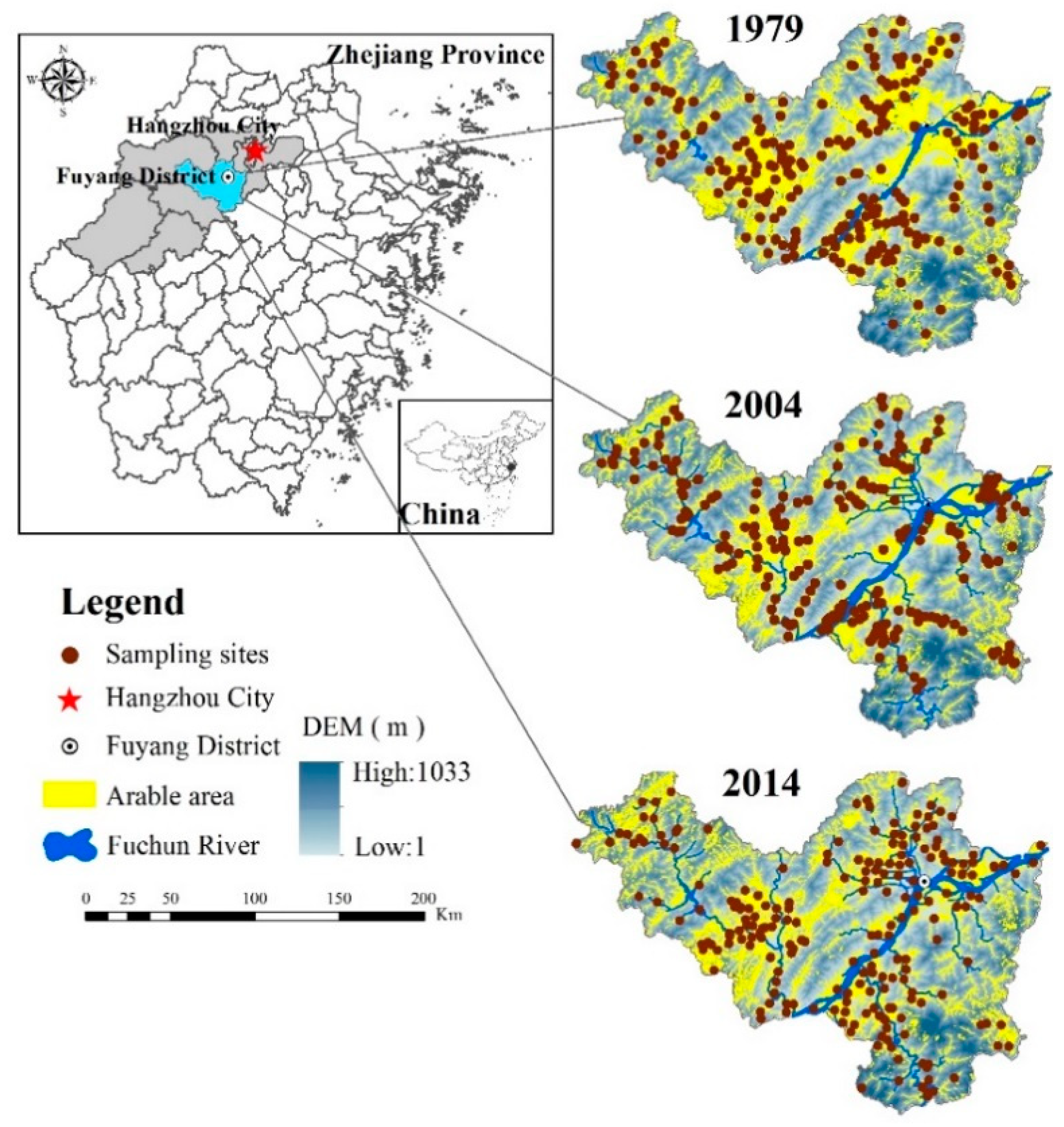
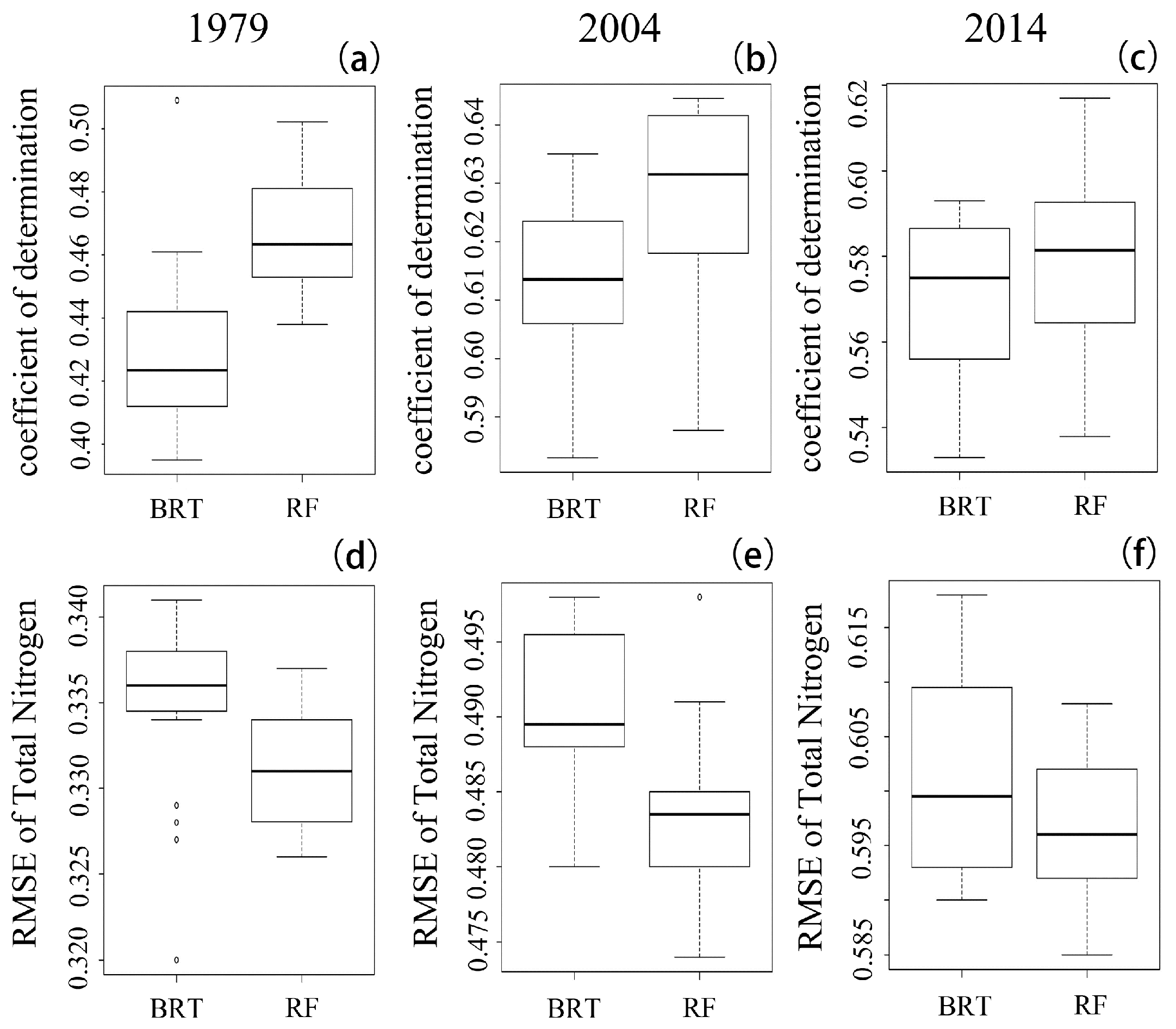



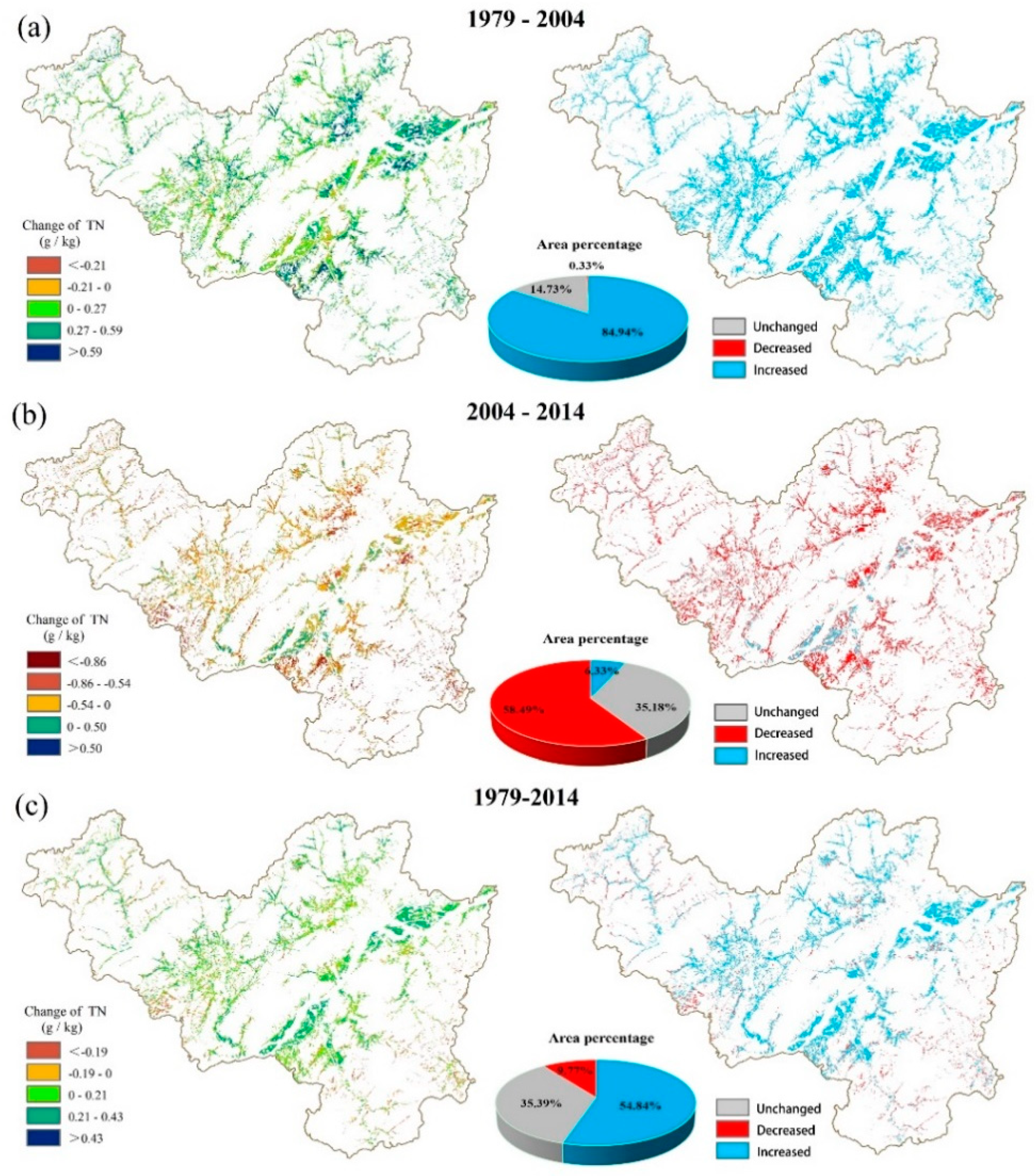


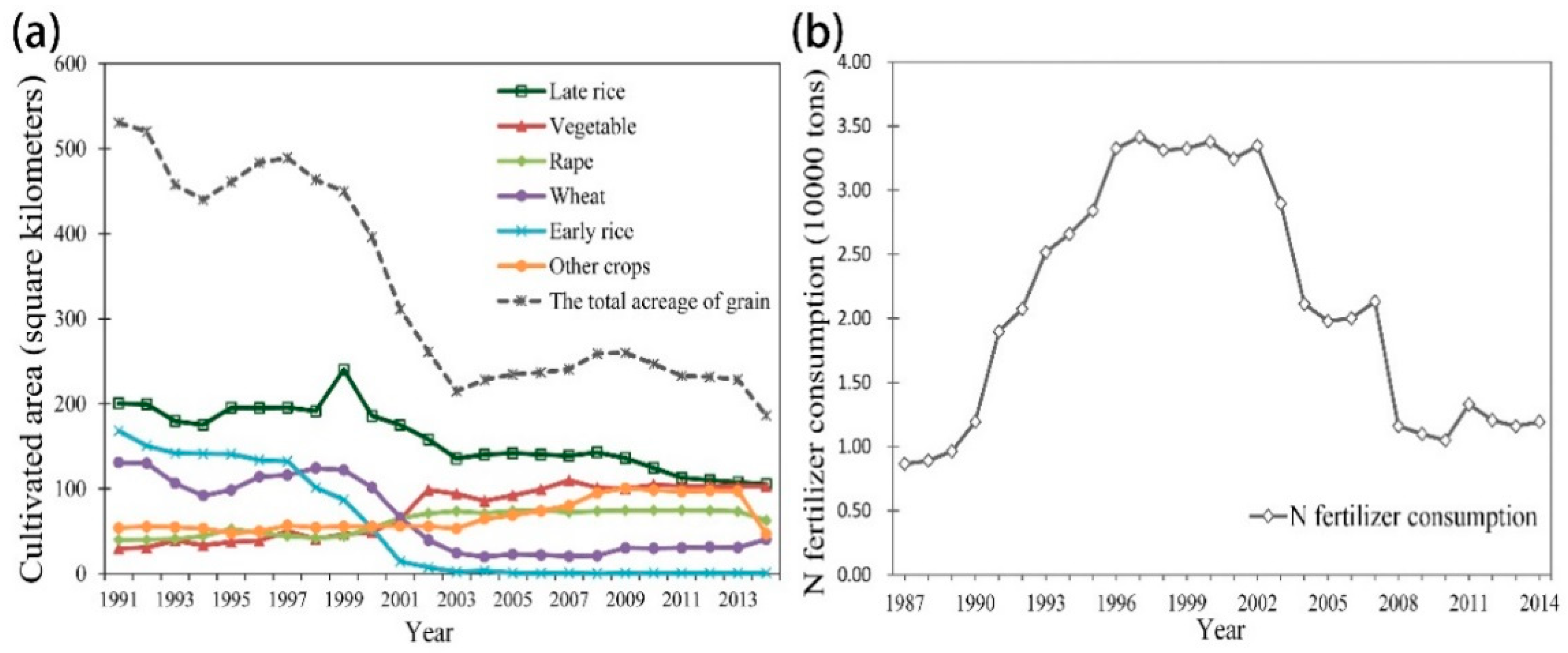
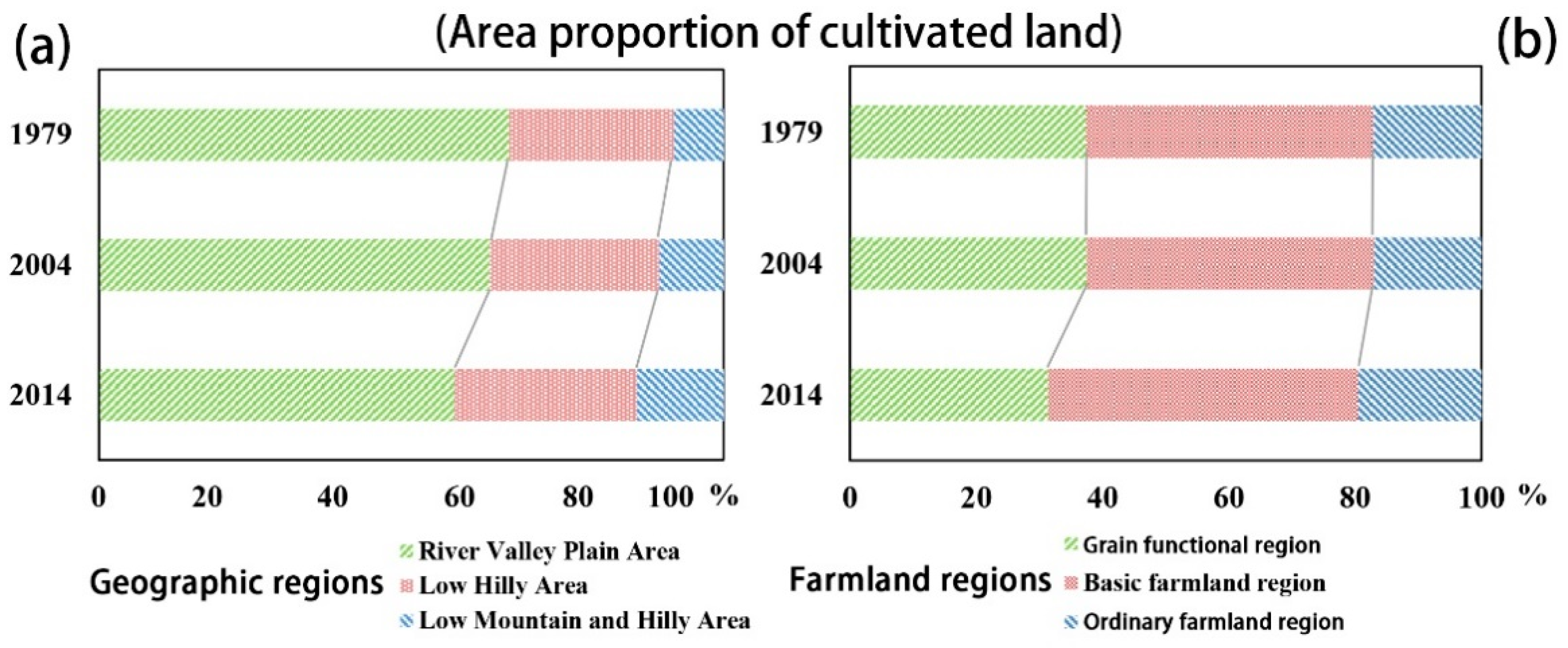
| Variables | Name | Unit | Scale | Source |
|---|---|---|---|---|
| Soil Type | ST | - | 1:50,000 | Digitized soil type map of Fuyang District |
| Climate | MAP | mm | 1000 m | World climate database (1950–2010) |
| MAT | °C | (http://www.worldclim.org/) | ||
| Topography | Elevation | M | 30 m | DEM data, Geospatial Data Cloud site, Chinese Academy of Sciences (http://www.gscloud.cn) |
| Slope | ° | |||
| TWI | - | |||
| Remote Sensing | BRed | - | 79 m & 30 m | Landsat 3 MSS on 5 August 1979 (79 m); Landsat 5 TM on 26 July 2004 (30 m); Landsat 8 OLI on 22 July 2014 (30 m); USGS (https://glovis.usgs.gov/) |
| BNIR | - | |||
| NDVI | - |
| Year | Number | Min (g/kg) | Max (g/kg) | Mean (g/kg) | SD (g/kg) | CV (%) |
|---|---|---|---|---|---|---|
| 1979 | 231 | 0.60 | 2.50 | 1.65 | 0.36 | 21.82 |
| 2004 | 267 | 0.44 | 3.70 | 1.90 | 0.56 | 29.47 |
| 2014 | 220 | 0.40 | 3.50 | 1.76 | 0.69 | 47.26 |
| Year | Elevation | Slope | TWI | MAT | MAP | ST | BRed | BNIR | NDVI |
|---|---|---|---|---|---|---|---|---|---|
| 1979 | 0.42 b | 0.24 a | −0.31 b | 0.18 | 0.36 b | 0.37 b | −0.01 | 0.21 | 0.15 |
| 2004 | 0.29 a | −0.06 | −0.41 b | −0.14 | 0.27 b | 0.24 a | −0.31 b | −0.33 b | 0.18 |
| 2014 | −0.21 a | −0.21 a | −0.29 | 0.22 | −0.32 b | 0.25 a | −0.11 | 0.44 b | 0.38 b |
| Year | Index | Min | Max | Mean | SD |
|---|---|---|---|---|---|
| 1979 | RMSE | 0.33 | 0.34 | 0.3312 | 0.0039 |
| R2 | 0.44 | 0.50 | 0.4677 | 0.0180 | |
| 2004 | RMSE | 0.47 | 0.50 | 0.4833 | 0.0054 |
| R2 | 0.59 | 0.64 | 0.6286 | 0.0149 | |
| 2014 | RMSE | 0.59 | 0.61 | 0.5968 | 0.0067 |
| R2 | 0.54 | 0.62 | 0.5796 | 0.0194 |
| Classification | Level | TN | 1979 | 2004 | 2014 | |||
|---|---|---|---|---|---|---|---|---|
| (g/kg) | Area (ha) | Percentage (%) | Area (ha) | Percentage (%) | Area (ha) | Percentage (%) | ||
| High | I | >2.0 | 0 | 0 | 8559 | 31.67 | 201 | 0.73 |
| II | 1.5–2.0 | 3395 | 11.07 | 16,183 | 59.89 | 11,982 | 43.55 | |
| Medium | III | 1.0–1.5 | 23,409 | 76.32 | 2280 | 8.44 | 14,671 | 53.32 |
| IV | 0.75–1.0 | 3868 | 12.61 | 0 | 0 | 620 | 2.22 | |
| Low | V | 0.5–0.75 | 0 | 0 | 0 | 0 | 40 | 0.2 |
| VI | ≤0.5 | 0 | 0 | 0 | 0 | 0 | 0 | |
| Region | Sub-Region | Characteristics |
|---|---|---|
| Farmland regions | Grain functional region | Relatively concentrated contiguous and well-established rice cultivation areas delineated by the Bureau of Agriculture |
| Basic farmland region | Higher-quality arable areas delineated by the Land and Resources Bureau. The scope of this area did not include the aforementioned grain functional region in the present study | |
| Ordinary farmland region | The remainder of cultivated land areas with lower-quality characteristics | |
| Geographic regions | River falley plain region | Mainly including valleys and river plains with a relative height ranging from 0 to 50 m |
| Low hilly region | With a relative height ranging from 50 to 150 m | |
| Low mountain and hilly region | Mainly including the surrounding low mountains and hilly areas with a relative height exceeding 150 m |
© 2018 by the authors. Licensee MDPI, Basel, Switzerland. This article is an open access article distributed under the terms and conditions of the Creative Commons Attribution (CC BY) license (http://creativecommons.org/licenses/by/4.0/).
Share and Cite
He, S.; Zhu, H.; Shahtahmassebi, A.R.; Qiu, L.; Wu, C.; Shen, Z.; Wang, K. Spatiotemporal Variability of Soil Nitrogen in Relation to Environmental Factors in a Low Hilly Region of Southeastern China. Int. J. Environ. Res. Public Health 2018, 15, 2113. https://doi.org/10.3390/ijerph15102113
He S, Zhu H, Shahtahmassebi AR, Qiu L, Wu C, Shen Z, Wang K. Spatiotemporal Variability of Soil Nitrogen in Relation to Environmental Factors in a Low Hilly Region of Southeastern China. International Journal of Environmental Research and Public Health. 2018; 15(10):2113. https://doi.org/10.3390/ijerph15102113
Chicago/Turabian StyleHe, Shan, Hailun Zhu, Amir Reza Shahtahmassebi, Lefeng Qiu, Chaofan Wu, Zhangquan Shen, and Ke Wang. 2018. "Spatiotemporal Variability of Soil Nitrogen in Relation to Environmental Factors in a Low Hilly Region of Southeastern China" International Journal of Environmental Research and Public Health 15, no. 10: 2113. https://doi.org/10.3390/ijerph15102113





